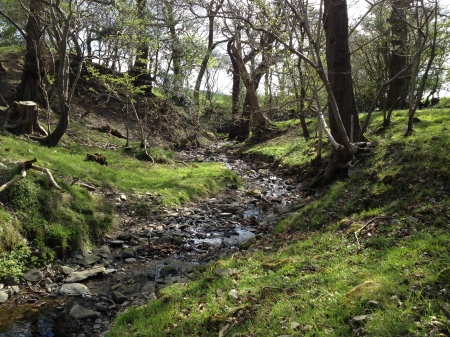In Australia, a creek can be a tiny meandering trickle or a gigantic floodout. Just ask Burke and Wills. But in Cumbria a beck is a beck is a beck.
I call the narrow sluice of permanently flowing water that runs down the centre of Styx Creek “the beck”. I call it that because it’s the right size: it’s “beck” sized. But there the resemblance ends because the beck in Styx Creek has been corralled and straightened into nothing more than a water sightline. Here’s what a beck should look like, up on Kirkby tops.
Sure, this is pretty small, even for a beck. That’s because it’s up on the fells and not far from the spring where it starts. But it’s still a beck.
This beck’s from further down the fells, at the head of a place called Birds Wood. It’s where I spent many a happy hour as a lad, getting muddy, making dams, climbing trees and raiding birds’ nests. (Not proud of that bit but, as those convicted British disc jockeys say, it was different in the Seventies.)
As I took this photo a woodpecker drilled a tattoo in the top of an old oak tree and lambs bleated in the croft next door. It was just as I remembered it.
This beck’s around the same elevation and so it’s similar in its topography. It has lots of rounded cobbles, which are great for making dams with, and trees big enough to have rope swings where the beck makes pools.
This last beck’s the least representative of the group but it’s still a beck. This one’s at a place called Roundsey (pronounced Runzy) Woods, near the estuary where the peat moss dirties the water. It’s on the side of the estuary where slave ships docked and disgorged their cargo, washed them and marched them over the tops to Whitehaven for export to the Americas. But that was the 1770s and, like the 1970s, things were different back then.
I’m emerging from a foggy period that began just before Easter and ended on the first day of May. Being around these becks and on these fells has been a great solace, but soon I’ll be back in Styx Creek with Jambo. I’ll look at that concrete sluice running like a gunshot from New Lambton to Islington and tell myself that it’s a beck, but I don’t really think so. It’s not really a creek either. I’ll have to find a new word. Any ideas?




Mark, nice to get a glimpse of your boyhood tramping ground.
Yes, Ruth. A glorious place to get filthy, get scrapes and grow up. Can’t beat a country upbringing!
You cannot drink
What’s ‘tween its banks
Styx beck, I think
Should be called “The Stanx”
Nice to hear from you again Mark – I was beginning to fear that the birds had got to you! (https://hamiltonnorth.wordpress.com/2015/03/20/an-unsettling-experience/)
Now a stanx; there’s a thought. What about a steck? Or a stynk? I’m liking this, Lachlan!
My first idea was the “Stynx”, because the words “smelly drain” come easily to mind. But when I thought about it, in all my cycling beside the drain I rarely smell anything, maybe an occasional muddy odour. What’s the scent like down in the drain?
For most of its length it’s entirely odourless, Lachlan. However, when atmospheric conditions are right the hundred yard section between the gasworks and the fuel depot can be a miasma of heavy fuel, naphtha and bitumen that just about knocks you out. On those occasions, “stynx” does not even begin to describe it!
Armed with this new olfactory information I shall return to my initial thought then, and offer this tongue twister.
The stench it sinks
‘Twixt Styx’s walls
Methinks ‘The Stynx’
The beck should be called
Dear Mark, Your talk of becks in Cumbria and alternative terms for such watercourses reminds me about the author Robert Macfarlane. Apparently his book Landmarks, celebrating and defending the language of landscape, was published in March 2015. It’s ‘a field guide to the literature of nature, and a vast glossary collecting thousands of the remarkable terms used in dozens of the languages and dialects of Britain and Ireland to describe and denote aspects of terrain, weather, and nature’. Here’s a lovely article by Macfarlane himself in The Guardian: http://www.theguardian.com/books/2015/feb/27/robert-macfarlane-word-hoard-rewilding-landscape
I’m looking forward to adding Landmarks to my teetering pile of backlogged books. But perhaps you already know about Macfarlane.
Hi Megan
I was recently in England on family business, but I did manage to get out into the real world on occasion. By “the real world” I mean the bookshops that still dot the high streets of some English towns and cities, and in doing so I managed to fill my suitcase with enough books to ensure it was given a “HEAVY” tag at the airport check-in.
Macfarlane’s book was one that I’d heard about but didn’t actually see, so it was wonderful to get your reminder post. I think I’ll have to add it to my teetering backlog too!
I think the saddest part about that review was the children’s dictionary’s decision on which words to drop and which to keep. I do a lot of work with Indigenous Australian languages and I’m occasionally asked “What’s the point? They’re going to die out anyway.” Those single words that need entire sentences to define the nuance and cultural meaning embedded within them is a perfect reminder of what we lose when we lose our linguistic diversity.
Thanks for the post!
Mark